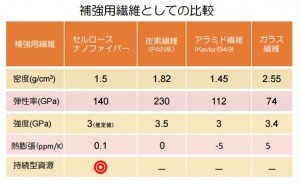Cellulose nano fiber ( CNF ) production
Cellulose nano fibers (CNF) are sometimes called as "Post carbon fiber". The research and development regarding CNF is advanced in Japan and Nippon Paper Industries Co., Ltd. seems to reach the next phase of CNF's business.
Reference information regarding Nippon Paper Industires Co., Ltd. cellulose nano fiber business (English version):
http://www.nipponpapergroup.com/english/products/cnf/
Nippon Paper Industries Co., Ltd. launched the new factory of manufacturing CNF in Shimane prefecture. The investment was 10 million U.S. $ and its capacity is 30 ton/year.
Mass media releases are referred below (basically Japanese)
NHK
http://www3.nhk.or.jp/news/html/20160818/k10010641671000.html
Nikkei
http://www.nikkei.com/article/DGXLASDZ17HH7_X10C16A8MM8000/?n_cid=NMAIL001
Sankei
http://www.sankei.com/economy/news/160518/ecn1605180002-n1.html
The stock values seem to be affected by this press release. It indicates that the news has a relative big impact on the industries.
Current application targets are cosmetic and food industries.
The viscosity change by heat will be drastically decreased and it enable to achieve very nice hand feeling.
Nippon Paper Industries Co., Ltd. has started the development of CNF since 2007 with Professor Akira Isogai of Tokyo University. The synthesis method of it consists of the chemical denaturation of cellulose via TEMPO catalyst oxidization reaction. This synthesis method has been already applied to CNF manufacturing in Ishinomaki Factory of Nippon Paper Industires Co., Ltd. and it was released in May 2016.
http://www.nipponpapergroup.com/news/year/2016/news160518003393.html
The new factory in Shimane Prefecture would indicate that the material would be developed for each application.
I have written a column regarding CNF before as shown below (in Japanese).
Cellulose has little risk of the short origin compared with carbon fiber. Japan has also plenty of forests and their application has been required recently from the life cycle management view point.
What do we need to think by the release?
Possibility of CNF application to FRP
The release mentioned;
CNF has possibility to be applied as the filler or reinforcement to resin composites.
It means that CNF application to FRP has already started considering.
What is the material properties of CNF ?
The comparison of the properties of CNF with CF ( Carbon fiber ), AF ( Aramid Fiber ), and GF ( Glass fiber ) is shown in the table below.

(The table regarding material properties is referred from "http://www.rish.kyoto-u.ac.jp/labm/wp-content/uploads/2013/02/d1aae6582cde72b6a423db01071722eb.pdf")
The density and strength is similar with AF(Kevlar®49); Modulus is 140 GPa , 30% higher than AF and twice of GF. CTE ( Coefficient of thermal expansion ) is pretty low like10E-7 /degree C.
CNF shows very high performance, even though tensile modulus is much lower than CF, so it's challenging to apply it to the primary structure parts.
Of course the value is elementary property value, so actual CNF fiber will not always show such a high performance.
But twice tensile modulus of GF let us expect that resin fiber composite of CNFRP would show pretty good performance, compared with GFRP under the same fiber volume and fiber length condition.
In addition, organic material CNF would show unique properties like damping character as similar as AF.
Wide view range and open discussion targeting final application
Japanese material technology is one of the best one all over the world. It would be true even though I have been involved the research and development project with companies/research institute among various countries.
But I am noticing that there is approach difference among Europe, U.S., and Japan.
I am not sure if there is best or not, but the distance between final assembly maker and material supplier in Europe and U.S. is much smaller than Japan. Of course it's not everything to all companies in Japan.
I have often given many advices to clients to make the distance as small as possible, but it's not so easy.
Final assembly basically believes that material is purchased like catalog base in Japan. Therefore, it's not easy for material suppliers to talk with final assembly makers regarding material requirement detail. Discussion content is very limited even though NDA is concluded.
By contrast, the discussion in Europe is very opened between assembly suppliers and material suppliers once the contract is concluded.
The content above is common belief but the similar situation is happened very often.
This condition is big issue because final assembly makers will not disclose their needs and requirement clearly, and material suppliers can't understand what their requirement is.
The very important point here is;
"Very wide and high point of view to see from material to final application"
Especially the people in final assembly maker is required to request that;
" We need the material which meets the requirement for final application."
The engineering requirement, considering the final application, is very important key to make the product concept clear, and to choose the proper materials.
I believe that such kind of requirement is the starting point to apply CNF to the wide range of industries.
I hope CNF will become the next reinforcement for resin matrix composite, though currently Nippon Paper Industires Co., Ltd. is targeting cosmetic and food industries.



